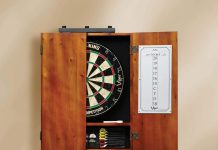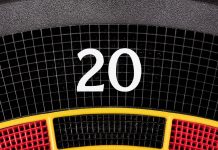Looking to up your dart game and hit that bullseye? Well, you’ve come to the right place! In this article, we will be exploring the age-old question: what is the best stance for throwing darts? Whether you’re a beginner or a seasoned pro, finding the ideal stance can make all the difference in your accuracy and consistency. So, let’s grab our darts and get ready to strike a pose!
Review contents
Stance Selection
Having the right stance is crucial for success in throwing darts. It not only provides stability but also helps in achieving accuracy and consistency. When it comes to stance selection, there are a few key factors to consider: feet alignment, weight distribution, body alignment, and consistency.
Feet Alignment
The alignment of your feet can significantly impact your stability and balance while throwing darts. There are two common options to consider: parallel and angled.
- Parallel: One option is to align your feet parallel to each other. This stance provides a stable foundation, allowing you to maintain balance throughout your throw. It’s a commonly used stance among dart players of all levels.
- Angled: Alternatively, you can angle your front foot slightly towards the target. This stance can offer better stability and alignment, as it allows for a more natural positioning of the body. Some players find this angle helps them generate more power in their throws.
Weight Distribution
The distribution of weight between your front and back foot is another vital element of a successful dart throwing stance. Finding the right balance can directly impact your control and accuracy.
- Front Foot: Placing more weight on your front foot can provide stability and control during the throw. This approach allows for a smoother follow-through and can help in achieving more accuracy.
- Equal Weight: Distributing your weight equally between both feet is another option. This stance provides a balanced foundation, enabling a more fluid motion throughout the throw.
- Back Foot: Some players opt for placing slightly more weight on their back foot. This stance can offer a stronger push-off, generating additional power and speed in the throw.
Body Alignment
Maintaining proper body alignment is essential for consistency and precision in dart throwing.
- Upright: Keeping your body upright helps in maintaining balance and control. It ensures that your arm and hand movement are not hindered during the throw, allowing for smoother execution.
- Slight Forward Lean: Alternatively, some players prefer a slight forward lean from the waist. This leaning position can assist in generating power and momentum, resulting in a more forceful throw.
Grip
The way you grip the dart greatly affects your control and accuracy. Let’s delve into the key elements of a good grip.
Loose vs. Firm Grip
Finding the right balance between a loose and firm grip is crucial. A grip that is too loose can result in an unstable release, while a grip that is too tight can inhibit smooth movement and control.
It’s recommended to find a grip that allows for a relaxed hold on the dart, without any unnecessary tension in the fingers or hand.
Finger Placement
Proper finger placement is key to maintaining stability and control throughout the throwing motion.
Most players find it beneficial to position the index, middle, and ring fingers towards the front of the dart, creating a tripod-like grip. This grip provides stability and control, preventing the dart from wobbling during release.
Thumb Position
The positioning of your thumb plays a crucial role in the stability and consistency of your throws.
Many players place their thumb along the back of the dart, applying gentle pressure to ensure a secure grip. This thumb placement aids in stability and control, allowing for smoother release and better accuracy.
Arm Position
The position of your arm can greatly impact the accuracy and power of your throw. Consider the following factors when determining your arm position:
Elbow Angle
Maintaining the right angle of your elbow is pivotal for a smooth throwing motion. A slight bend in the elbow helps generate power and helps in achieving a consistent release.
Straight vs. Slight Bend
While a straight arm position can be effective for some, many players find that a slight bend in the elbow provides better control and accuracy. This slight bend allows for a more natural and relaxed throwing motion.
Distance from Body
The distance between your dart-throwing arm and your body can also influence your throw. Some players prefer to keep their arm close to their body for stability and control, while others find a slightly extended arm position more comfortable. Experiment and find the distance that works best for you.
Shoulder Position
Maintaining the right shoulder position during a throw is vital for consistency and fluidity. Consider the following aspects:
Relaxed Shoulders
Relaxing your shoulders is crucial to prevent unnecessary tension or stiffness. Relaxed shoulders allow for a more natural throwing motion and greater control.
Raised vs. Lowered
The position of your shoulders can vary from player to player. Some prefer slightly raised shoulders, while others find a lowered shoulder position more comfortable. Experiment with both and see which one allows for the smoothest and most consistent throwing motion.
Parallel to the Floor
Keeping your shoulders parallel to the floor helps in achieving a balanced and controlled throw. This alignment allows for a smoother follow-through and ensures that your shoulder movement doesn’t negatively impact your accuracy.
Head Position
While it’s easy to overlook the head position, it can actually have a significant impact on your throw. Consider the following aspects:
Eyes on Target
Ensuring that your eyes are focused on the target throughout the throw is crucial for accuracy. Keep your gaze fixed on the intended target, allowing your brain to align your body and arm accordingly.
Straight Neck vs. Tilted
Finding the right head position is a matter of personal preference. Some players prefer to keep their neck straight, while others find a slight tilt towards the throwing arm helps in maintaining balance and control. Experiment and choose the head position that feels most comfortable and natural to you.
Follow-Through
The follow-through is the final part of a dart throw and can significantly impact the outcome. Pay attention to the following elements:
Smooth Release
A smooth release is essential for achieving accuracy and consistency. Avoid any jerky or abrupt movements during the release, and focus on maintaining control and fluidity.
Arm Extension
Extending your arm fully during the follow-through helps ensure a complete and controlled release. Allow your arm to extend naturally, following through towards the target. This extension aids in generating power and accuracy.
Hand Position
Your hand position at the end of the throw can provide valuable feedback on the success of your motion. Ideally, your hand should be pointing towards the target, with your fingers relaxed and following the line of your throw. This hand position indicates a proper release and can contribute to better accuracy.
Practice and Adjustments
Becoming proficient at throwing darts requires practice, observation, and analysis. Consider the following strategies to improve your technique:
Experimentation
Don’t be afraid to experiment with different stances, grips, and other elements of your throw. This process allows you to identify what works best for you and helps develop a consistent and effective technique.
Observation and Analysis
Take the time to observe and analyze your throws. Watch videos of your technique or have someone record you while you throw. Look for any inconsistencies or areas for improvement, and adjust your technique accordingly.
Seeking Professional Advice
If you’re serious about improving your dart throwing skills, consider seeking guidance from a professional. A qualified coach or experienced player can provide valuable insights and help you fine-tune your technique to reach your full potential.
Remember, achieving a successful dart throw is a combination of proper stance, grip, body alignment, and follow-through. Focus on consistency and practice regularly to develop muscle memory and improve your accuracy. With dedication and a friendly competitive spirit, you’ll soon be hitting your targets with precision and style!

























![Best Outdoor Dartboards [Reviews and Buying Guide 2024] Best Outdoor Dartboards](https://gamersets.com/wp-content/uploads/2022/12/Best-Outdoor-Dartboards-100x70.jpg)

![Best Mini Air Hockey Table [Reviews & Buying Guide 2024] Best mini air hockey table](https://gamersets.com/wp-content/uploads/2022/10/Best-mini-air-hockey-table-100x70.jpg)







